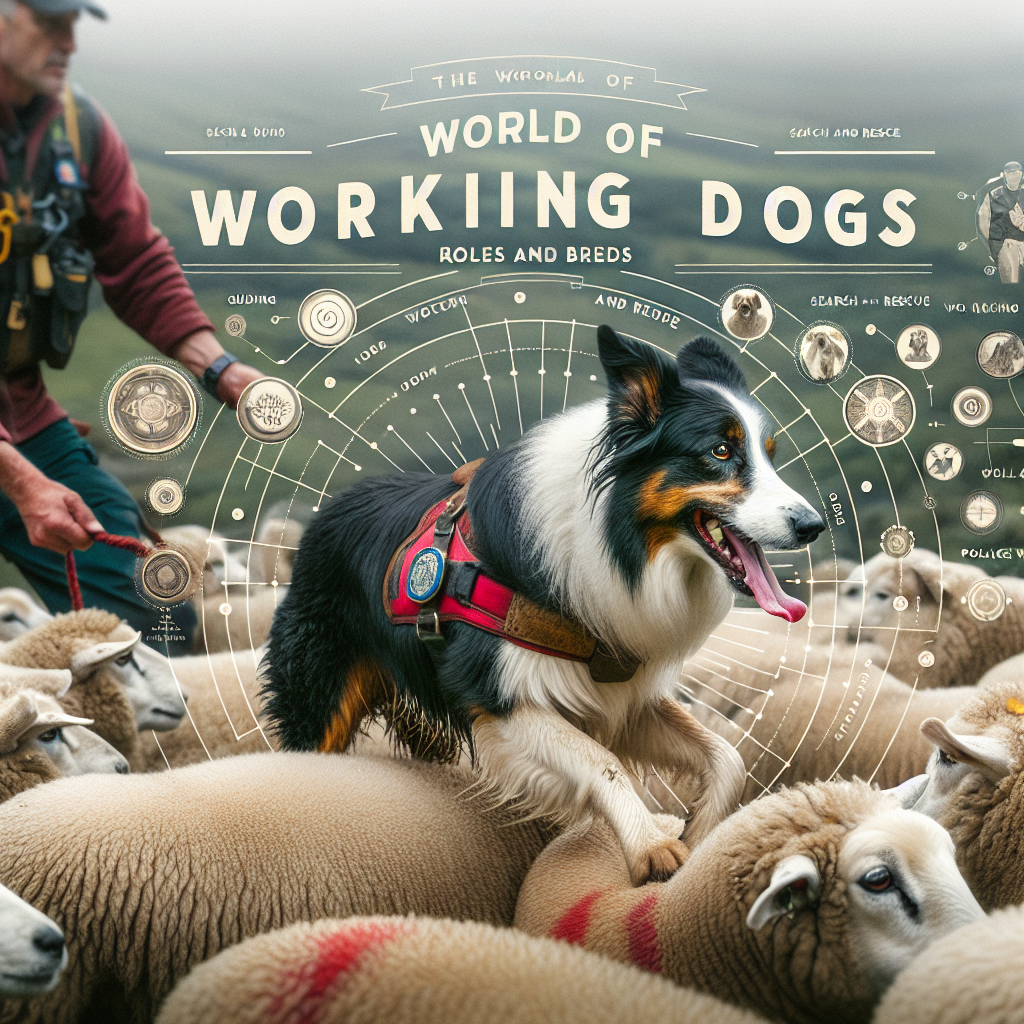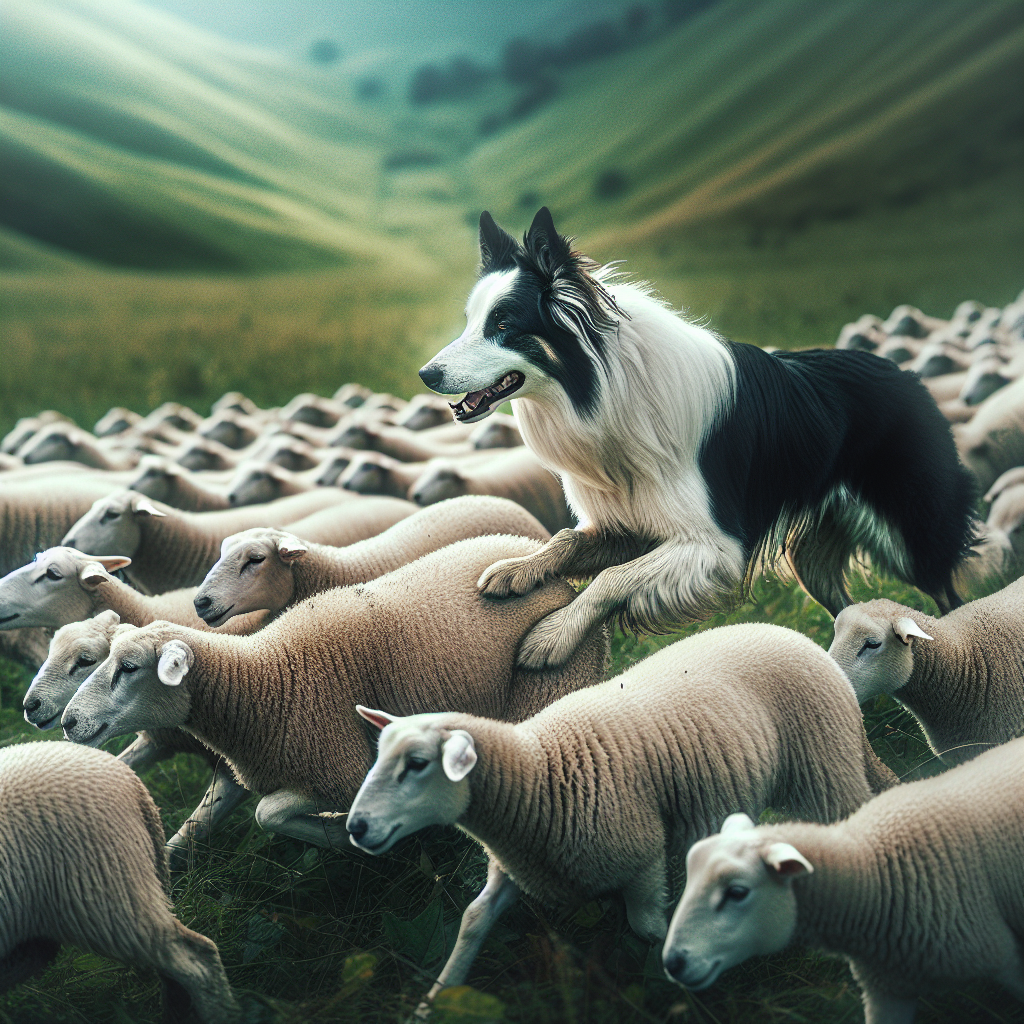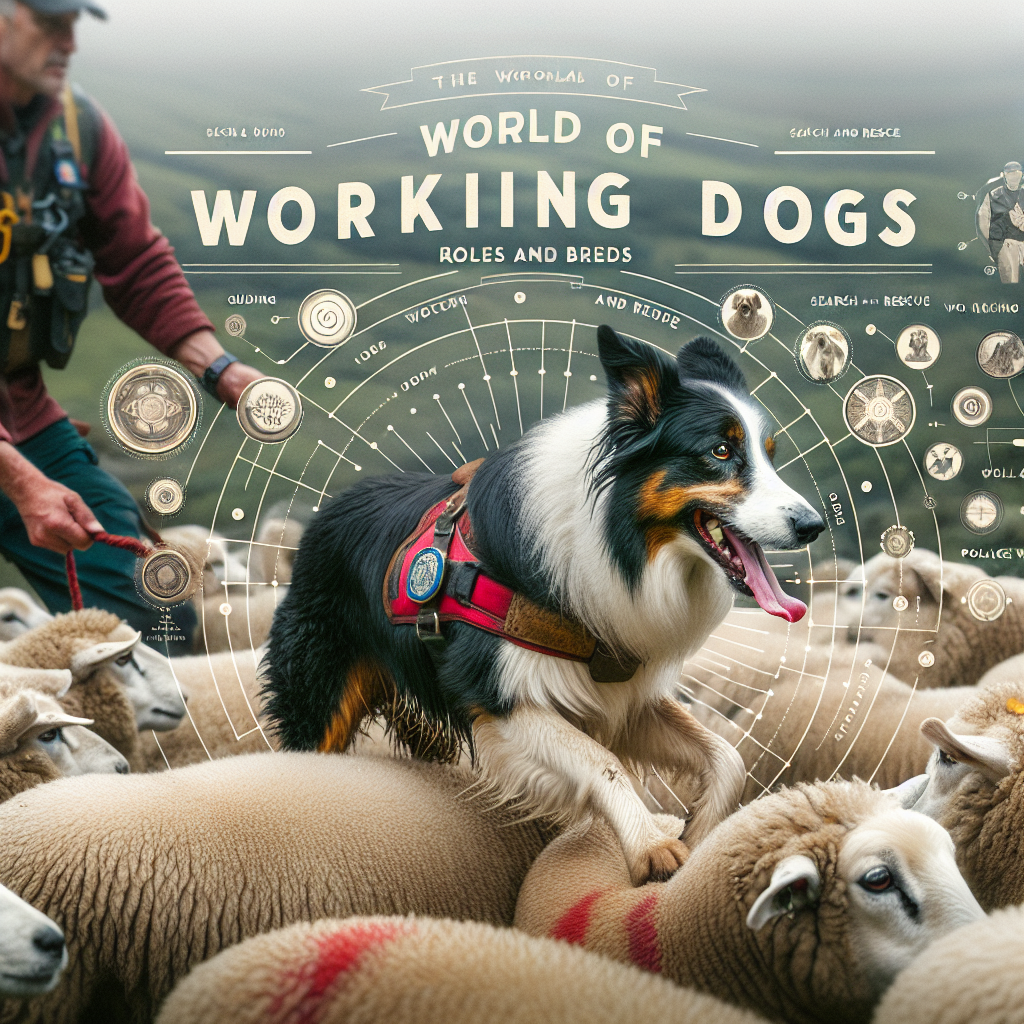Imagine a world where dogs are not just adorable companions, but also skilled professionals. In the fascinating realm of working dogs, these four-legged heroes contribute to society in a multitude of ways. From search and rescue operations to assisting people with disabilities, their roles are as diverse as the breeds themselves. Whether it’s the highly intelligent Border Collie herding sheep with precision or the determined German Shepherd protecting our cities as police dogs, these remarkable animals play an invaluable part in our everyday lives. So sit back, and let’s explore the captivating world of working dogs and the incredible roles they fulfill.
Working Dogs Overview
Working dogs are a special category of canines that have been selectively bred and trained to perform specific tasks. These remarkable dogs possess a unique set of skills, instincts, and characteristics that enable them to excel in their designated roles. From herding livestock to assisting people with disabilities, working dogs play a vital role in various fields, showcasing their intelligence, loyalty, and versatility.
Definition of a working dog
A working dog is a canine that has been purposefully bred to perform specific tasks and fulfill certain roles. Unlike companion or decorative dogs, working dogs are valued primarily for their skills and abilities rather than their appearance. These dogs go through specialized training to develop the necessary skills that enable them to assist humans in everyday tasks or perform important roles in various industries.
History of working dogs
The history of working dogs can be traced back thousands of years when humans started domesticating canines. Ancient civilizations recognized the unique abilities and instincts of dogs and began selectively breeding them to enhance specific traits that were valuable in their respective societies. From herding livestock in ancient agricultural communities to hunting alongside early humans, working dogs have been indispensable partners throughout history.
Roles of working dogs
Working dogs fulfill a wide range of roles in different industries and organizations. Some common roles include herding livestock, search and rescue operations, police and military work, service to individuals with disabilities, therapy and emotional support, sled pulling, assistance for individuals with medical conditions, guard duty, and hunting assistance. Each role requires specialized training and specific breed characteristics to ensure the dog’s effectiveness in fulfilling its duties.
Importance of working dogs
Working dogs play a crucial role in society by assisting humans in various tasks, enhancing safety and security, and providing invaluable support to individuals with disabilities or medical conditions. These dogs possess exceptional skills, loyalty, and dedication, enabling them to perform tasks that would otherwise be challenging or impossible for humans alone. Their presence and contributions have a significant impact on both the individuals they assist and the communities they serve.
Herding Dogs
Breed characteristics
Herding dogs, also known as shepherd dogs, have been bred for their exceptional herding instincts and abilities. These dogs typically have high energy levels, intelligence, agility, and a strong desire to work. They possess excellent communication and problem-solving skills, enabling them to easily control and guide livestock. Common breed characteristics of herding dogs include a strong work ethic, natural herding instinct, alertness, and responsiveness to commands.
Herding instincts and skills
Herding dogs have a natural instinct to gather and control groups of animals. They use a combination of eye contact, body language, and barking to communicate with livestock and guide them in the desired direction. These dogs can effectively manage large flocks or herds, preventing them from scattering or straying. They are capable of quick and precise movements, allowing them to navigate through challenging terrain while keeping the livestock together and safe.
Famous herding dog breeds
Several dog breeds are renowned for their exceptional herding abilities. The Border Collie, known for its intelligence and agility, is considered one of the best herding dogs. Australian Shepherds, with their high energy levels and versatility, excel in herding a variety of livestock. The German Shepherd, though primarily known for police and military work, also possesses excellent herding instincts. Other notable herding dog breeds include the Old English Sheepdog, Belgian Malinois, and Shetland Sheepdog.

Search and Rescue Dogs
Breed characteristics
Search and rescue dogs are highly trained canines that assist in locating missing persons or individuals in distress. These dogs must exhibit exceptional senses, agility, endurance, and trainability. Key breed characteristics for search and rescue dogs include a strong sense of smell, excellent hearing, physical stamina, intelligence, and the ability to work in various terrains and weather conditions.
Search and rescue training
Search and rescue dogs undergo extensive training to refine their natural abilities and develop specific search and rescue skills. They are trained to track scents over long distances, locate buried or hidden individuals, conduct swift water and aerial searches, and provide assistance in disaster situations. Their training involves obedience, agility, scent detection, and search techniques to ensure they can effectively locate and alert their handlers to the presence of a missing person.
Notable search and rescue dog breeds
Different breeds excel in search and rescue roles due to their specialized characteristics. The Labrador Retriever, with its exceptional sense of smell and friendly nature, is widely used in search and rescue operations. The German Shepherd’s intelligence, agility, and versatility also make it well-suited for these tasks. Other notable search and rescue dog breeds include the Bloodhound, Golden Retriever, Belgian Malinois, and St. Bernard.
Police and Military Dogs
Breed characteristics
Police and military dogs, often referred to as K-9 units, exhibit specific characteristics that make them suitable for these demanding roles. These dogs must possess loyalty, courage, intelligence, agility, and a strong protective instinct. Physical traits such as strength, endurance, and speed are also desirable. Moreover, their temperament should be stable, allowing them to remain calm and focused even in high-stress situations.
Police dog training
Police dogs undergo intensive training to be effective partners for law enforcement officers. They are primarily trained in obedience, tracking, criminal apprehension, and narcotics or explosives detection. Police dogs work alongside their handlers, assisting in pursuits, crowd control, search operations, and drug investigations. Their specialized training allows them to provide invaluable support, enhance officer safety, and aid in reducing crime rates in communities.
Military dog training
Military dogs are specially trained to perform tasks in military operations, including tracking, patrolling, guarding, and detecting explosives or enemy combatants. These dogs are extensively trained in obedience, agility, scouting, assault work, and specialized tasks such as mine detection. Military working dogs have proven to be invaluable assets on the battlefield, enhancing soldiers’ safety, and providing critical support in combat zones.
Prominent police and military dog breeds
The German Shepherd is one of the most commonly used breeds in police and military work due to its intelligence, versatility, and trainability. Belgian Malinois, known for their agility and work ethic, are also widely utilized in these roles. Other prevalent police and military dog breeds include the Dutch Shepherd, Rottweiler, Doberman Pinscher, and Labrador Retriever.

Service Dogs
Types of service dogs
Service dogs are specially trained canines that assist individuals with disabilities, providing them with increased independence and support. There are various types of service dogs, each specializing in a specific area. Guide dogs assist individuals with visual impairments, alerting them to obstacles and guiding them to their desired locations. Hearing dogs help individuals with hearing impairments by alerting them to sounds and important signals. Mobility assistance dogs assist individuals with physical disabilities by retrieving items, opening doors, and providing stability and balance.
Tasks performed by service dogs
Service dogs perform a wide range of tasks tailored to their handler’s needs. They can be trained to retrieve medication, detect allergens, provide deep pressure therapy for anxiety or sensory overload, interrupt destructive behaviors, and assist with tasks such as turning on lights or operating household appliances. Service dogs are not only reliable helpers but also offer emotional support and companionship to their handlers.
Service dog breeds
Service dogs can represent various breeds depending on the type of assistance required. Labrador Retrievers and Golden Retrievers are commonly used as guide dogs due to their intelligence, gentle demeanor, and willingness to work. Poodles, with their hypoallergenic coats and trainability, are suitable as hearing assistance dogs. Other breeds commonly used as service dogs include German Shepherds, Border Collies, Australian Shepherds, and Bernese Mountain Dogs.
Therapy Dogs
Benefits of therapy dogs
Therapy dogs provide emotional support and comfort to individuals in various settings such as hospitals, nursing homes, schools, and rehabilitation centers. These dogs offer stress relief, help reduce anxiety, encourage social interaction, and provide a sense of calm and happiness. Interacting with therapy dogs has been shown to lower blood pressure, release endorphins, and improve overall emotional well-being.
Training and certification
To become therapy dogs, canines must undergo specialized training to ensure they have the right temperament, social skills, and obedience. They are socialized to interact with people of diverse ages, backgrounds, and abilities. Therapy dogs must remain calm and well-behaved in unpredictable environments and be comfortable with being touched and handled. Certain organizations offer certification programs for therapy dogs and their handlers to ensure the highest standard of training and professionalism.
Popular therapy dog breeds
Various breeds excel as therapy dogs due to their friendly nature, adaptability, and ease of training. Labrador Retrievers, known for their gentle and affectionate temperament, make excellent therapy dogs. Golden Retrievers, with their patient and tolerant nature, are also commonly seen in therapy work. Other popular therapy dog breeds include Cavalier King Charles Spaniels, Border Collies, Poodles, and Greyhounds.
Sled Dogs
Breed characteristics
Sled dogs, also referred to as mushing dogs, are specifically bred for their ability to pull sleds in snowy and icy terrains. These dogs possess a sturdy build, endurance, excellent stamina, and a thick double coat to withstand extreme cold conditions. They must also have a strong work ethic, resilience, and the ability to work well in teams, as they often pull heavy loads over long distances.
Sled dog racing
Sled dog racing is a popular sport in which teams of sled dogs, guided by a musher, compete to cover a specific distance in the shortest time possible. Races can range from short sprints to long-distance treks lasting several days. The most famous sled dog race is the Iditarod Trail Sled Dog Race held annually in Alaska, covering over a thousand miles of challenging terrain. Sled dog races showcase the incredible speed, strength, and teamwork of these remarkable dogs.
Famous sled dog breeds
The Siberian Husky is one of the most recognizable sled dog breeds, known for its endurance, speed, and friendly temperament. Alaskan Malamutes, with their strength and power, are also commonly used in sled dog racing. The Canadian Eskimo Dog, Samoyed, and Greenland Dog are other notable sled dog breeds that excel in cold, harsh climates and are well-equipped to endure the challenges of long-distance sled racing.
Assistance Dogs
Definition and types of assistance dogs
Assistance dogs are highly trained canines that provide specific support to individuals with disabilities or medical conditions. There are different types of assistance dogs, including guide dogs, hearing dogs, medical alert dogs, and psychiatric service dogs. These dogs are trained to perform specific tasks tailored to the individual’s needs, enabling them to overcome daily challenges and live more independently.
Tasks performed by assistance dogs
Assistance dogs are trained to perform diverse tasks to assist individuals with disabilities or medical conditions. Guide dogs assist individuals with visual impairments by navigating obstacles, finding landmarks, and leading them safely through their surroundings. Hearing dogs alert individuals with hearing impairments to important sounds such as doorbells, alarms, or approaching vehicles. Medical alert dogs can detect changes in a person’s blood sugar levels, provide support during seizures, or alert to allergens. Psychiatric service dogs provide emotional support and perform tasks to aid individuals with mental health conditions, including anxiety or PTSD.
Assistance dog breeds
Different breeds of dogs are suitable for specific assistance tasks due to their temperament, intelligence, and trainability. For guide dogs, Labrador Retrievers and Golden Retrievers are commonly used due to their intelligence, willingness to work, and strong bond with their handlers. Cocker Spaniels and Miniature Poodles are commonly trained as hearing assistance dogs due to their alertness and trainability. For medical alert and psychiatric service dogs, breeds such as the Labrador Retriever, Standard Poodle, and German Shepherd are often utilized.
Guard Dogs
Characteristics of a good guard dog
Guard dogs possess specific traits that make them suitable for protecting property, livestock, or individuals. These dogs are typically highly territorial, loyal, and possess a strong protective instinct. They are naturally suspicious of strangers and have a loud, intimidating bark. A good guard dog should be confident, trainable, well-socialized, and agile enough to swiftly respond to potential threats. However, it is important to note that proper training and socialization are crucial for a guard dog to distinguish between genuine threats and harmless situations.
Guard dog training
Guard dogs undergo specialized training to fulfill their role effectively while maintaining a balanced temperament. Their training focuses on obedience, protection, and controlled aggression. Guard dogs learn to respond to commands, assess potential threats, and demonstrate appropriate protective behavior without being overly aggressive or dangerous. Proper training ensures that these dogs are reliable and obedient while providing a deterrent effect to potential intruders.
Well-known guard dog breeds
Several breeds are renowned for their guarding abilities and make excellent choices for this role. The German Shepherd is a popular breed used for guard work due to its intelligence, loyalty, and protective nature. Rottweilers, known for their strength and intimidating appearance, are also commonly used as guard dogs. Doberman Pinschers, with their speed and agility, excel in guarding roles. Other notable guard dog breeds include the Bullmastiff, Boxer, and Belgian Malinois.
Hunting Dogs
Breed characteristics
Hunting dogs have been selectively bred for centuries to assist in various types of hunting. These dogs possess specific traits that make them valuable assets to hunters. They typically exhibit a keen sense of smell, excellent tracking abilities, high energy levels, endurance, and the courage to confront and retrieve game. Hunting dogs come in various sizes and forms, with each breed specializing in a particular type of hunting, such as bird hunting, small game hunting, or tracking larger game.
Hunting dog training
Hunting dogs undergo training to develop and refine their natural hunting abilities. They are trained to track scents, flush out game, point or retrieve birds, and work in harmony with their handlers. Training typically involves obedience, controlled aggression, scent detection, retrieving, and responding to specific hunting commands. A well-trained hunting dog can significantly enhance a hunter’s success and overall experience in the field.
Popular hunting dog breeds
There are numerous hunting dog breeds that excel in different hunting environments and game types. Labradors Retrievers, known for their versatility and trainability, are commonly used for waterfowl hunting. Pointers, such as the German Shorthaired Pointer and English Pointer, are renowned for their ability to locate game and freeze in a pointing position. Spaniels, including Cocker Spaniels and Springer Spaniels, excel in flushing out game birds. Other notable hunting dog breeds include Beagles, Bloodhounds, Vizslas, and Weimaraners.
Working dogs are truly exceptional animals that have proven their value time and time again. Their unwavering loyalty, intelligence, and remarkable skills enable them to excel in a wide range of roles and provide invaluable support to humans in numerous fields. From search and rescue operations to assisting individuals with disabilities, working dogs have a significant impact on our lives and communities. Their unwavering dedication deserves our admiration, respect, and appreciation for their tireless efforts to make the world a better place.

